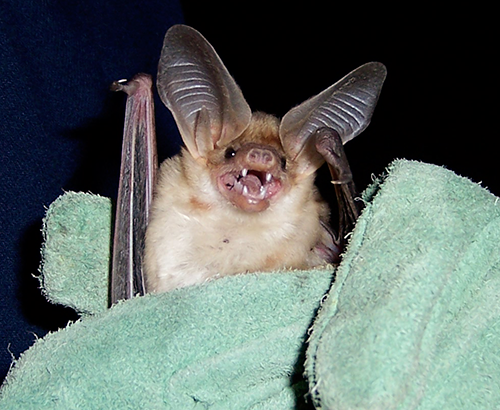show/hide words to know
Rabies
Many people think that all bats have rabies. This is simply not true. While bats can contract the rabies virus, very few do. In fact, less than 1/2 of 1% of bats have rabies.
What Exactly is Rabies?
Rabies is a disease that affects the nervous system and the brain. Rabies is a type of virus. The most common way to get the rabies virus is if a rabid animal bites you. Any mammal can contract rabies including dogs, cats, raccoons, foxes, skunks, coyotes, bats, and even humans.
Rabies is a serious disease and can be fatal if left untreated. Fifty-five thousand people around the world will die this year from rabies and rabid dogs cause 99% of these cases. Most of the rabies cases around the world occur in Asia, Africa, and Latin America. In the United States, raccoons, skunks, foxes, and bats are the main animals that get rabies.
What is the Best Way to Prevent Rabies?

The best way to prevent the spread of rabies is making sure that you vaccinate your dogs, cats, and ferrets against the disease. There are very few cases of rabies in the United States each year because most pet owners get their dogs, cats, and ferrets vaccinated.
You can only get rabies if a rabid animal bites you or if you come in contact with its saliva. That means you cannot get rabies just by looking at a bat. Most bats will only bite in self-defense.
If you come across a bat, the best thing to do is not touch it. If you wake up and there is a bat flying in your room, you should tell your parents or an adult right away. If a bat bites you, you should wash the bite really well with soap and water. Next you should tell an adult and go to a doctor immediately. If the bat is still around, an adult can carefully pick up the bat using leather gloves or another tool to avoid touching it and bring it to the doctor. The doctor can then test the bat to see if it has rabies.
If the bat doesn’t have rabies, you have nothing to worry about. If the bat does have rabies, the doctor will give you a series of shots that will prevent you from getting rabies.
References:
Centers for Disease Control and Prevention(link is external)
Bat Conservation International(link is external)
View Citation

Be Part of
Ask A Biologist
By volunteering, or simply sending us feedback on the site. Scientists, teachers, writers, illustrators, and translators are all important to the program. If you are interested in helping with the website we have a Volunteers page to get the process started.









